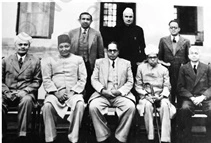
Practice worksheet for Chapter 10 The Constitution of India–An Introduction Class 7 Subject- Social Science
Worksheet
The Constitution of India – An Introduction
Class-7
Subject-Social Science
A. Multiple Choice Questions (1 mark each)
(10 Questions × 1 = 10 marks)
- Which of the following best describes the Constitution of India?
a) A religious text
b) A document defining laws and principles of governance
c) A historical novel
d) A book of poetry - How many women were part of the Constituent Assembly?
a) 10
b) 12
c) 15
d) 20 - The Constitution was written over a period of nearly:
a) 1 year
b) 2 years
c) 3 years
d) 4 years - Who was the President of the Constituent Assembly?
a) B.R. Ambedkar
b) Mahatma Gandhi
c) Jawaharlal Nehru
d) Rajendra Prasad
5. Which part of the Constitution contains guidelines for the government to ensure social welfare?
a) Preamble
b) Fundamental Duties
c) Directive Principles of State Policy
d) Fundamental Rights
More:
The idea of an independent judiciary was taken from which country’s Constitution?
a) UK
b) USA
c) France
d) AustraliaThe phrase “Let noble thoughts come to me from every side” reflects:
a) Irish wisdom
b) Roman ideals
c) Indian openness to global ideas
d) British governanceWhich Constitutional Amendment added Fundamental Duties?
a) 42nd
b) 73rd
c) 61st
d) 15thWhich article ensures the protection of monuments and cultural heritage?
a) Article 21
b) Article 49
c) Article 14
d) Article 41
10. What concept was inspired by the Irish Constitution?
a) Secularism
b) Liberty
c) Fundamental Duties
d) Directive Principles
True or False (1 mark each)
(5 Questions × 1 = 5 marks)
1. The Constitution can never be changed or amended.
2. The Indian Constitution was adopted on 26 November 1949.
3. The judiciary in India has the power to review laws.
4. Citizens do not have any responsibility under the Constitution.
5. India adopted universal adult franchise from the beginning.
Fill in the Blanks (1 mark each)
(5 Questions × 1 = 5 marks)
1. The Constitution provides a structure for the __________, executive, and judiciary.
2. The Constitution of India was handwritten by __________.
3. The Directive Principles are __________, not enforceable by law.
4. The __________ of India expresses the core values of the Constitution.
5. The phrase “Vasudhaiva Kutumbakam” means __________.
To download Full Worksheet Click Below:
Chapter 10- The Constitution of India–An Introduction
Chapter 11-From Barter to Money
Chapter 12- Understanding Markets
MCQs-
Chapter 11-From Barter to Money